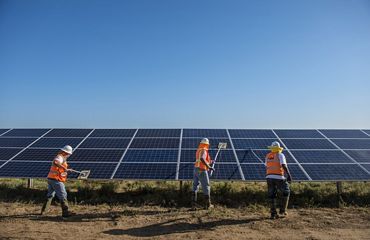
The Climate Ambition Gap
How a new vision of the voluntary carbon market can help the world reach critical climate targets.
By Campbell Moore, Managing Director, Carbon Markets & Peter W. Ellis, Director of Natural Climate Solutions Science
8-minute read time
The clock is ticking on our shared climate ambition: We must reach net-zero greenhouse gas emissions by 2050, if not sooner.
Although progress has been made, the world is still not on track to achieve this goal. Surpassing 1.5°C of global warming implies dangerous and widespread impacts on earth. We are currently on track for 2.7°C. Time is no longer a luxury the world has to close this climate ambition gap. The reality is clear: we need to use every ready, proven and scalable tool now.
Quote
The reality is clear: we need to use every ready, proven and scalable tool now to address the global climate crisis.
An Unprecedented Ambition
Closing the climate ambition gap on a relevant timescale requires a level of determination and global coordination unprecedented in human history. We must eliminate 150 billion tons of greenhouse gas pollution between now and 2030.
And there is no silver bullet when it comes to climate solutions—but there is a lot of silver buckshot. Our number one priority must be to decarbonize society. There is no plausible way out of the climate crisis if we don’t transition to renewable energy.
What are Natural Climate Solutions?
Natural Climate Solutions are actions to protect, better manage and restore nature to reduce greenhouse gas emissions and store carbon. Forests provide much of that carbon-storage opportunity.
Another one of the biggest pieces of buckshot in terms of near-term solutions is nature. TNC-led research has found that protecting, managing and restoring ecosystems can deliver 1/3 of the needed mitigation by 2030. As confirmed by the IPCC’s 6th Assessment Report, natural climate solutions (NCS) are, "the only ones in which large scale carbon dioxide removal (CDR) may currently and at short term be possible.”
We need to move incredibly fast to close the climate ambition gap. In order to do that we need to unlock hundreds of billions of dollars in climate finance from sources ranging from public to private to philanthropic.
Quote

We need to move incredibly fast to close the climate ambition gap. In order to do that we need to unlock hundreds of billions of dollars in climate finance from sources ranging from public to private to philanthropic.
The Private Sector and the Climate Ambition Gap
Corporate responsibility is key to closing the global climate ambition gap. This global gap is mirrored in nearly every individual corporation, where the trajectory of their current emissions is far off track from the much steeper reduction needed.
Comprehensive Climate Action
Carbon markets are only one tool in the toolbox for addressing the existential threat of climate change. TNC supports a comprehensive climate strategy including massive decarbonization, wide-scale renewable energy, and natural climate solutions funded through the voluntary carbon market and other sources. Read more about our 2030 climate goals.
As we highlighted before, the most important step to close this gap is for corporations to ramp up their decarbonization ambitions across their operations and their value chains. But this approach alone is not enough. Although nearly 1,000 publicly companies have made a net-zero commitment, only 7% of companies are on track to meet those targets.
To help companies close that remaining gap in near-term targets, they need a global-scale system to fund additional credible climate action like NCS, beyond their borders, that otherwise wouldn’t happen.
Closing the Corporate Ambition Gap: The Voluntary Carbon Market
A system that would effectively support companies to close the corporate ambition gap, which now threatens to derail their net-zero commitments, must cover an array of crucial traits. Rules must be science-backed and independently verified to build trust and prevent greenwashing. It also needs to ensure that climate projects protect people and nature by implementing effective safeguards.
What are carbon markets?
A carbon market is a system for buying and selling carbon credits. These credits allow companies, governments and other organizations to address parts of their greenhouse gas emissions by funding projects and programs designed to avoid or reduce carbon dioxide released into the atmosphere. Explore our illustrated guide to the Voluntary Carbon Market.
The system also needs to provide a fluid way for funding to reach these verified climate action opportunities, and a compelling incentive for investors to fund additional climate action.
This system would need to be immediately scalable and have a transition plan to make sure it did not become an excuse to delay decarbonization.
The Voluntary Carbon Market (VCM)—as the world’s only global carbon market—is aiming for this outcome and can set the foundation for the government-regulated carbon markets that must follow.
The State Carbon Credits Are In
While the Voluntary Carbon Market has enormous potential and a long list of innovative projects that protect and restore nature and improve lives around the world, it is not flawless. The last few years have seen a string of both valid and sensational critiques of the VCM. These critiques have destabilized the ecosystem of this nascent market.
Many fear that carbon credits might allow companies to postpone their own essential decarbonizing actions at best and greenwash at worst. This is a concern that we share.
Fortunately, there is a growing body of research that demonstrates that companies that invest in carbon credits are also decarbonizing almost twice as fast as companies that aren’t active in the VCM. More importantly, initiatives like the Voluntary Carbon Markets Integrity Initiative (VCMI) have sparked a global dialogue on how—and how not—to use carbon credits and avoid greenwashing risk.
There are also concerns about whether some carbon credits actually represent the emission reductions or removals they claim to, or whether they are just claiming credit for something that would have happened anyways.
Fortunately, there has been substantial recent progress in raising the floor for the integrity of carbon projects through a new global standard for the entire VCM (IC-VCM), and new cutting-edge methodologies have raised the ceiling for the market by applying some of the best science humanity has to offer.
It is also important to acknowledge that the Voluntary Carbon Market acts as a proving ground for innovation and for the science and rules that governments can later build into regulated (compliance) carbon markets.
Quote

Companies that invest in carbon credits are decarbonizing almost twice as fast as companies that aren’t active in the VCM.
A New Age for the Voluntary Carbon Market
We cannot afford to let the VCM fail. At the moment, there is no ready, scalable substitute to play this role in keeping the global project of corporate net-zero on track.
Additionally, millions of landowners and communities around the world—mostly in the Global South—have taken a gamble and planted trees, changed their livelihoods away from deforestation or altered their farming practices in anticipation of being a part of the climate solution and having a better life from expected carbon finance. We should fix any issues in the VCM—not pull the rug out on the Global South.
How can communities benefit from the VCM?
A carbon project can reduce emissions from deforestation that ultimately is caused by poverty and lack of economic opportunity. By co-designing new sustainable livelihood options that reduce or remove extra carbon emissions, the project can generate transformational revenue from carbon credit sales that are directed back into the community to support education, healthcare and other needs.
A high quality VCM can rapidly scale climate action and provide financing for it. A trusted Voluntary Carbon Market could grow from its present $1-2 billion per year to $100 billion by 2030 and as high as $1 trillion per year by 2050 (or even earlier).
Ultimately, the story of the Voluntary Carbon Market is the story of a journey. We need a path forward that acknowledges and transparently addresses valid critiques. But we also need room for improvement that doesn’t tear down the best tool we have for closing the corporate climate ambition gap.
The current VCM was built for another era when carbon credits were mostly used for feel-good marketing. That era is over. The net-zero era requires an upgrade to a carbon market that always produces high-quality carbon credits: Version 2.0 of the VCM.
Quote
VCM 2.0 is driven by top-tier science, with clear rules for corporate use alongside decarbonization efforts, and which aligns with the Sustainable Development Goals.
The Next Step in Our Journey: VCM 2.0
VCM 2.0 is driven by top-tier science, with clear rules for corporate use alongside decarbonization efforts, and which aligns with the Sustainable Development Goals.
Global initiatives like the IC-VCM and the VCMI are setting quality benchmarks for carbon credits that demonstrate valuable progress. But the road does not end there. We have still much work to be done to build VCM 2.0 with consistently demonstrated impact.
Carbon markets hold an exceptional promise to help bridge the climate ambition gap and help the world reach our net zero goal. It is an urgent climate imperative to help it reach its full potential and it won’t happen on its own.
So let’s get to work.
About the Authors
As TNC’s Managing Director of Carbon Markets, Campbell Moore works with a global team to ensure integrity in nature-based carbon market projects.
Peter W. Ellis leads a global team of scientists that conduct research to motivate and inform the design and implementation of natural climate solutions.
Global Insights
Check out our latest thinking and real-world solutions to some of the most complex challenges facing people and the planet today.


